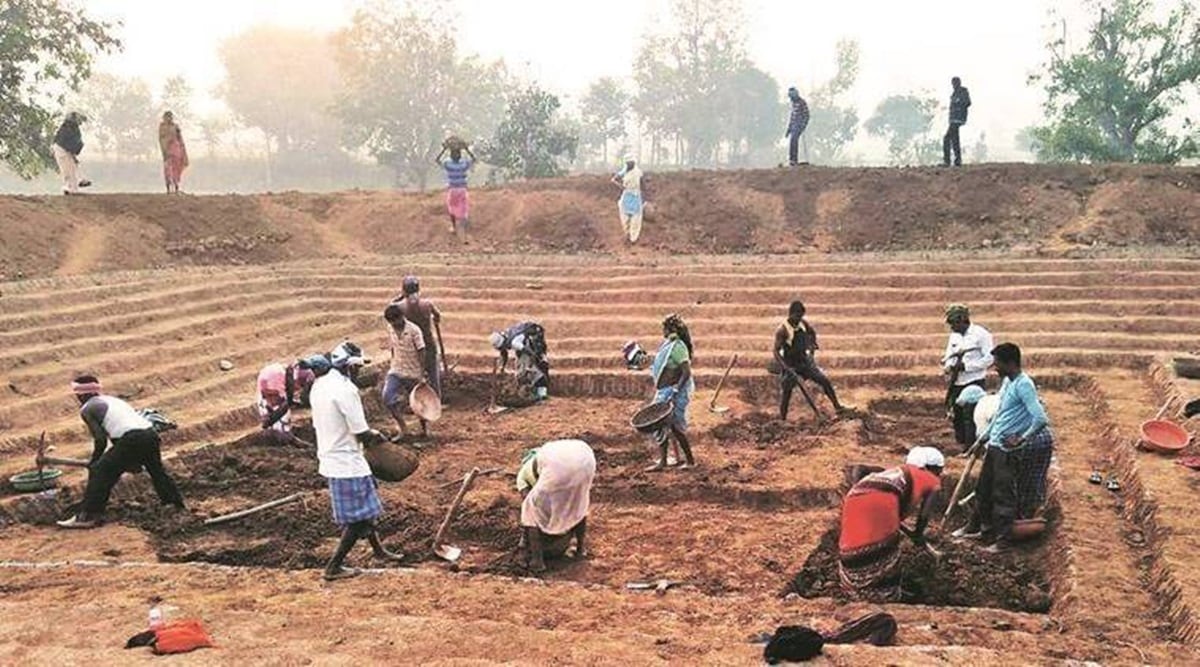 The MGNREGA, among other social security programmes, can be a powerful safety net for the poor. But delays in payments continue even in such precarious times.
The MGNREGA, among other social security programmes, can be a powerful safety net for the poor. But delays in payments continue even in such precarious times. (Written by Ranadheer Malla)
The Mahatma Gandhi National Rural Employment Guarantee ct (MGNREGA) was a pivotal shock absorber during the first wave of the pandemic. Its functioning hinges on sufficient budget allocation, reliable payment systems, and ease of access to wages. However, the Government of India (GoI) not only reduced the MGNREGA budget this year but also neglected it in subsequent relief measures post the second wave. The MGNREGA, among other social security programmes, can be a powerful safety net for the poor. But delays in payments continue even in such precarious times.
Under the Act, workers should get wages within 15 days of completion of work failing which they are entitled to compensation for delays. The MGNREGA payment process consists of two stages. After work is completed, a Funds’ Transfer Order (FTO) with worker details is digitally sent to the GoI by the panchayat/block. This is the state’s responsibility. The GoI then processes the FTOs and transfers wages directly to the workers’ accounts. This is called Stage 2 and is entirely the GoI’s responsibility. The Act’s guidelines say that the first stage must be completed in eight days and the second within seven days after Stage 1. However, as per official data, only 26 per cent of the transactions of the first quarter of this financial year were credited within the stipulated seven-day period by the GoI.
Until recently, every MGNREGA FTO consisted of multiple transactions of workers across caste categories. On March 2, the GoI issued a circular to change the payment system so that payments can be made separately based on the caste of workers (SC, ST and “Others”).
To understand the efficacy of this circular, we obtained all wage transactions from April 1, 2021, to May 23, from 26 randomly sampled blocks of Jharkhand. The objective was to assess the difference in Stage 2 of the payment process across caste categories. We calculated Stage 2 delays for these transactions and combined them with the caste category of the workers. Out of 3,14,710 transactions for which the FTO was sent to the GoI, 54.3 per cent of transactions remained unpaid as of May 23. The caste category of workers was missing for 7,097 transactions. We were, therefore, able to calculate caste-wise Stage 2 delays for 1.43 lakh transactions.
The GoI took 26 days on average to process the transactions in the second stage. We do not find any evident difference in the time taken to complete this stage of the payment process across SC, ST, and “Others” categories. In a previously conducted study of 90 lakh transactions across 10 states, we found that Stage 2 alone was taking more than 50 days. These delays were completely unaccounted for as they were not reflected in the MGNREGA MIS. Based on these findings, in 2018, the Supreme Court gave strong orders reprimanding the GoI for not paying compensation for the delay it was causing. Three years hence, the GoI continues to violate the Act and court orders. What is more surprising is that such inordinate delays are being observed at the beginning of the financial year, when the programme is meant to be flush with funds.
During such an unprecedented crisis, the move of segregating payments by caste categories raises apprehensions. While affirmative action is important, experimenting with the payment architecture without transparent discussions or a justified rationale appears bizarre. The Secretary of the Ministry of Rural Development (MoRD) told the media that the purpose was to assess how much the SC/ST communities benefited from MGNREGA. While the purpose of knowing the amount of money accrued to SC/ST households is useful, it can easily be calculated after the wage payments are completed. Tinkering with the payment process, without consultation, sends a worrying signal, given that there have been attempts to erode the universality of MGNREGA. For instance, in 2016, the then Joint Secretary of the Ministry had sent WhatsApp messages to field functionaries saying “While the Act does not distinguish between APL and BPL and vulnerable/non-vulnerable, we have to intelligently communicate to the district/block/GP authorities to learn to target.”
The digital payments system of MGNREGA has been a laboratory of many experiments since 2012. However, no mechanism to solicit feedback from workers to evaluate the robustness of these systems has ever been created. In this case, there was no consultation with the state governments either. It is no surprise then that Stage 2 of the payment process is taking three times more than it should. India boasted 4,355 crore digital retail transactions in 2020-21 as per RBI data. These are usually completed within a day if not in a few minutes. In comparison, MGNREGA transactions, which are only 1.6 per cent in the volume of these, get routinely delayed. Why should the timely payment of subsistence wages in MGNREGA continue to be so elusive?
Dhorajiwala and Malla are researchers with LibTech India. Rajendran teaches at Azim Premji University
- The Indian Express website has been rated GREEN for its credibility and trustworthiness by Newsguard, a global service that rates news sources for their journalistic standards.

